Duxford Imperial War Museum - Aug 2011
Join us on a fascinating tour of Duxford, in
Cambridgeshire, part of the Imperial War Museum. Just off
junction 10 on the M11, Duxford's huge historic military aviation
museum comprises some eight areas containing wonderfully preserved
wartime fighter and bomber aircraft from Britain's aviation heritage
plus some captivating civil aeroplanes, including a Concorde which we
walked on! Mike found the 1940 Operations Room and vintage
wireless sets enthralling while Belinda liked the military men in
combat gear in the Battle of Britain and Land Warfare sections!
|
|
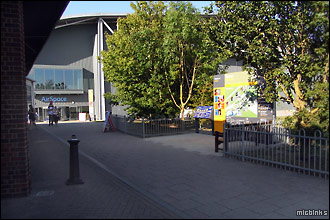
After passing through the visitor center at IWM Duxford we were greeted
by this giant info board illustrating the museum layout; we headed left
to the main exhibition area called AirSpace.
|
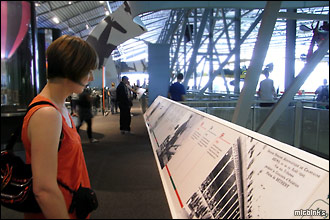
This timeline in AirSpace's upper area depicted flight development over
the years, here there were plenty of 'hands on' interactive exhibits
with lots of buttons to push demonstrating how all things aviation work.
|
|
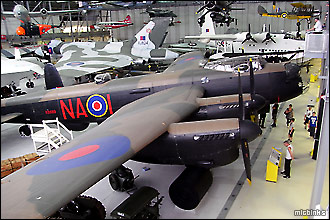
Can you spot three iconic military aircraft here at Duxford Imperial
War Museum? In the foreground is the famous Lancaster WWII
bomber, behind it the huge Vulcan bomber of the 60s and to the right
the Sunderland flying boat.
|
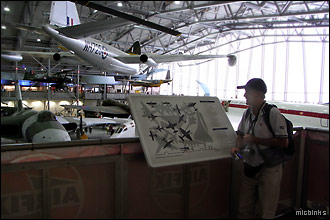
There are some 30 aircraft in Duxford's AirSpace, this info board
pinpointed all the historic aircraft to spot. And it's not only
military aircraft, there are some classic civil planes too, like that
Concorde behind that seemingly only just managed...
|
|
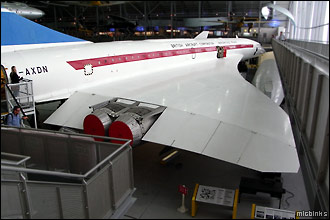
...to squeeze its very aesthetically pleasing form into the huge
AirSpace hanger. A few years back we toured a Concorde at Fleet Air Arm Museum, we did the
same here at Duxford with...
|
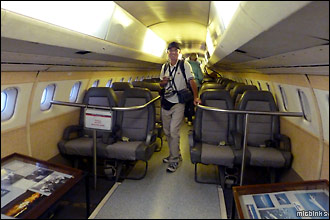
...a walk through the fuselage. This Concorde was a development
model originally loaded with test gear, the seats were added later to
reflect its commercial use. Back to the military aircraft then
and...
|
|
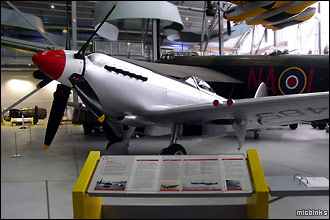
...the legendary WWII fighter, the Spitfire. Duxford's No. 19
squadron was the first to get them but this particular one's a late
version Supermarine Spitfire F24. Throughout the museum there
were plenty of these informative info boards to browse.
|
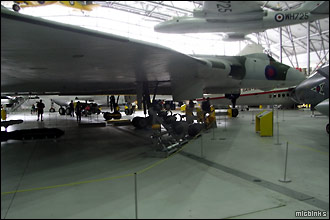
And now a closer look at the Vulcan with its massive delta-wings.
The Vulcan was the aircraft that carried the UK's strategic
nuclear weapons during the Cold War, later carrying conventional
weapons and last used for combat in the Falklands War.
|
|
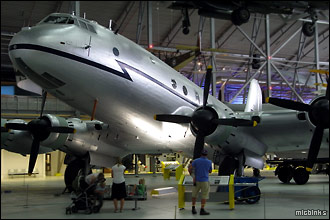
As you can imagine we took loads of pics at Duxford Imperial War
Museum. This is the Hastings C1A, an RAF long range transport
aircraft and Hastings were extensively used for the Berlin Airlift.
|
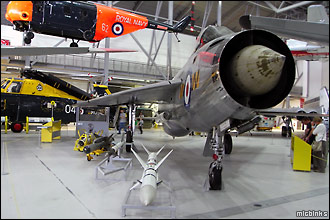
The Lightning F1 was a supersonic interceptor fighter that saw RAF
service from the 60s to the 80s. The Lightning was distinctive for its
imposing large jet engine air intake up front.
|
|
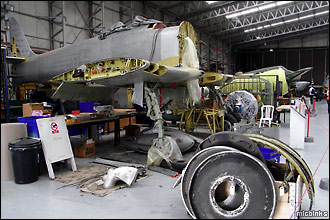
Next up was the Flying Aircraft hanger at Duxford IWM containing some
privately owned planes under restoration. Looks like there's a
bit more than an evening's work to do on this one so on to...
|
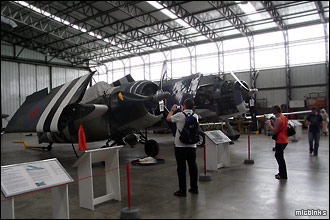
...Duxford's Air and Sea exhibition area; those planes with the folding
wings are the Wildcat FM-2 and were the mainstay fighter aircraft of
the US Navy during the middle part of the Second World War.
|
|
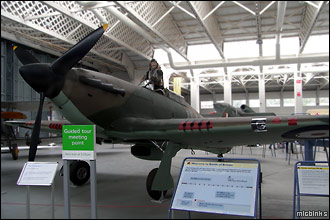
On entering the Battle of Britain section we were greeted by this jolly
chappie sitting up there in this Hawker Hurricane, the RAF's main
British fighter of WWII. Regarded as the forgotten star of the
Battle of Britain, there were far more Hurricane squadrons (including
two at Duxford) than the Spitfire.
|
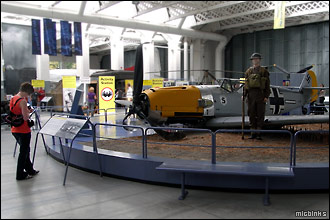
The German's famous fighter of the Second World War was the
Messerschmitt Bf 109E and the scene depicted here in the Battle of
Britain hall shows an actual Messerschmitt that crashed being
guarded. An Anderson Bomb Shelter and a V1 Flying Bomb were among
the many exhibits in Battle of Britain.
|
|
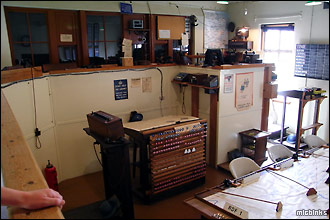
One highlight of our visit to Duxford IWM was the recreation of the
1940 Operations Room, brought vividly to life by the excellent
soundtrack playing of all the frantic activity that took place as
aircraft were directed and tracked during battle.
|
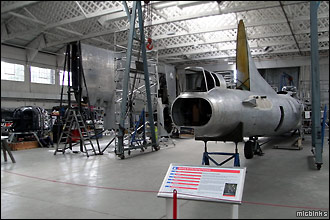
Here in Conservation in Action we saw restoration work being carried
out on many aircraft; this one's a B-17G Flying Fortress in bits, its
wing hanging to the left, and a Frazer-Nash FN-120 four-gun tail
turret. OK, we'll soon have that back together then!
|
|
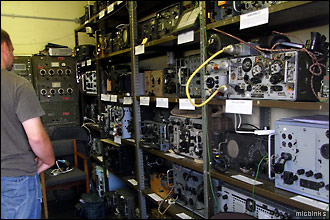
Just look at all those vintage wireless sets in the Duxford Radio
Society's area! Mike recognised much of the kit from the surplus
market of the 70s during his innings as a young enthusiastic radio ham
(callsign G4BFJ). Next door had a mock up of...
|
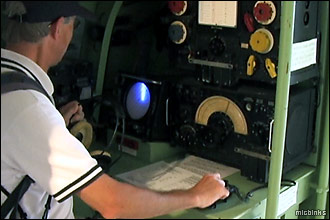
...the Lancaster's wireless operator area with a T1154 transmitter up
top and R1155 receiver below. Mike had his first go with a Morse
key in over 25 years and found it all flowed back when he managed to
tap out Belinda's name in Morse Code. Dar-de-de-dit...
|
|
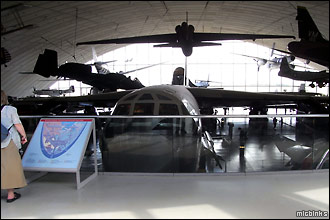
The American Air Museum was dominated by the simply enormous Boeing
B-52 Stratofortress bomber, and many aircraft here were suspended from
the roof as if in combat.
|
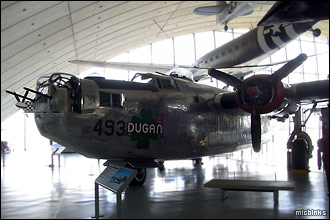
This is the B-24M Dugan, which proved a tricky shot into the
light. Among other aircraft in the American Air Museum at Duxford
were a Phantom, Thunderbolt, Avenger and the stealthy SR-71 Blackbird.
|
|
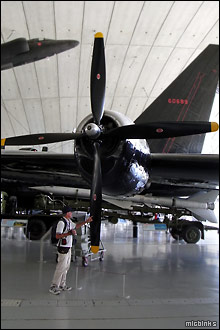
You'll need more than your finger
to start up that one up Mike!
|

Duxford's airfield was in constant use all day with aircraft landing
and taking off. This is a T-6 Harvard coming in to land after
taking (some very rich!) people on a pleasure flight. Duxford
also hosts various airshows during the summer season.
For more Duxford information please visit our UK tourist resources.
|
|
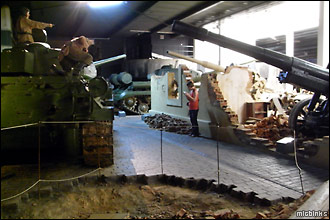
Land Warfare was our last port of call at Duxford Imperial War Museum
with many displays including 'The Normandy Experience' and 'The Eastern
Front', all with tons of tanks and other ground military
hardware. Get outta there Belinda, it's a war zone!
|
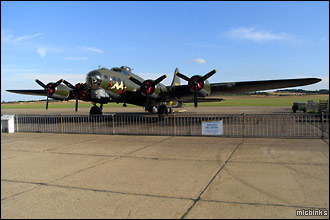
As we headed back to Duxford's visitor centre, Sally B, the last
airworthy B-17 Flying Fortress in Europe, had just come in to
land. Sally B is based at IWM Duxford and regularly flies at
airshows so presumably it had just returned from one.
|
|
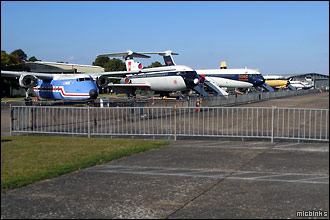
Lined up here are some historic civil commercial aeroplanes sitting on
the tarmac at Duxford, including a Dart Herald, Trident, VC-10,
Britannia and BAC 1-11, all sporting airline livery of old such as BEA,
BOAC and Monarch Airlines.
|
Duxford adult entry at the time of our visit was £14.95.
But beware the misleading entrance fee trick!
On the Duxford website it has £16.50 in the prominent cost table, but
this includes a voluntary donation only denoted by an asterisk.
Only in smaller text further down does it say the actual cost is
£14.95. And they try it on at the visitor centre too, asking for
the higher cost but on querying it they quickly relent. To cap it
all there's a donations box which could cause unsuspecting visitors to
pay a further voluntary donation! All a bit underhand
Imperial War Museum!
Otherwise, we can thoroughly recommend IWM Duxford; it
sure is a captivating day out for all and an important part of
Britain's military and civil aviation heritage.
|
